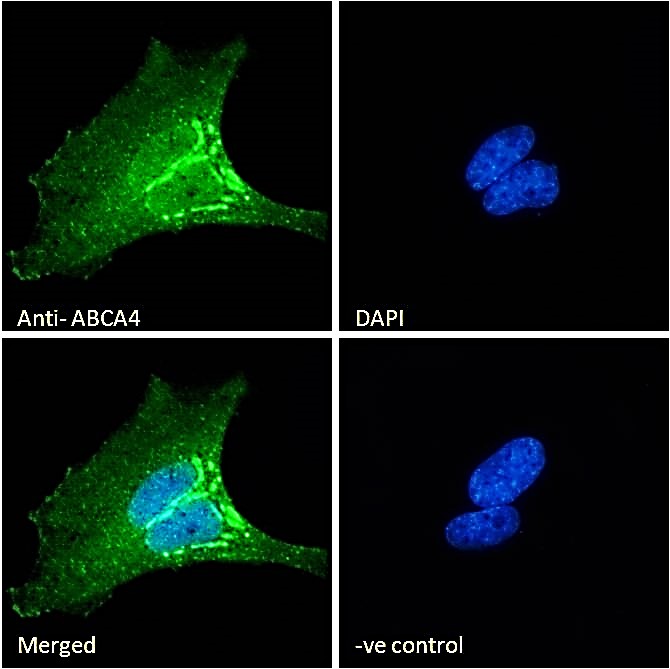Formulation Supplied at 0.5 mg/ml in Tris saline, 0.02% sodium azide, pH7.3 with 0.5% bovine serum albumin.
| |
Unit Size 100 µg | |
Storage Instructions Aliquot and store at -20°C. Minimize freezing and thawing. | |
Synonym / Alias Names rim protein|retina-specific ABC transporter|ATP-binding transporter, retina-specific|ATP-binding cassette, sub-family A member 4|ATP binding cassette transporter|STGD1|STGD|RP19|RMP|FFM|DKFZp781N1972|CORD3|ARMD2|ABCR|ABC10|ATP-binding cassette, sub-family A (ABC1), member 4|ABCA4 | |
Usage Summary Immunofluorescence: Strong expression of the protein seen in the Endoplasmic Reticulum of MCF7 and HeLa cells. Recommended concentration: 10µg/ml. This antibody has been successfully used in IF on Mouse, PMID: 32371886. | |
Accession ID NP_000341.2 | |
Blocking Peptide EBP08615 | |
Immunogen Peptide with sequence C-KQQTESHDLPLHPR, from the C Terminus of the protein sequence according to NP_000341.2. | |
Peptide Sequence C-KQQTESHDLPLHPR | |
Purification Method Purified from goat serum by ammonium sulphate precipitation followed by antigen affinity chromatography using the immunizing peptide. | |
Shipping Instructions Refrigerated | |
Predicted Species Human, Dog | |
Reactive Species Human, Mouse | |
Human Gene ID 24 | |
Product Grade  | |
ELISA Detection Limit Antibody detection limit dilution 1:128000. | |
Application Type Pep-ELISA, IF |
Goat Anti-ABCA4 Antibody
$423.00
| SKU | Unit Size | Price |
|---|---|---|
Select a unit size:
Selected References [{"pmid": 35348597, "intro": "This antibody has been successfully used in the following paper:", "title": "Assessing Variant Causality and Severity Using Retinal Pigment Epithelial Cells Derived from Stargardt Disease Patients.", "author": "Anna Matynia, Jun Wang, Sangbae Kim, Yumei Li, Anupama Dimashkie, Zhichun Jiang, Jane Hu, Samuel P. Strom, Roxana A. Radu, Rui Chen, and Michael B. Gorin", "journal": "Transl Vis Sci Technol. 2022 Mar 2;11(3):33."}, {"pmid": 32371886, "intro": "This antibody has been successfully used in IF on Mouse:", "title": "The F220C and F45L rhodopsin mutations identified in retinitis pigmentosa patients do not cause pathology in mice.", "author": "Tylor R Lewis, Camilla R Shores, Martha A Cady, Ying Hao, Vadim Y Arshavsky, Marie E Burns", "journal": "Sci Rep. 2020 May 5;10(1):7538."}] |


